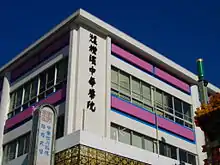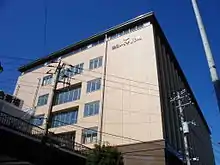Chinese people in Japan
Chinese people in Japan include any people self-identifying as ethnic Chinese or people possessing Chinese citizenship living in Japan. People aged 22 or older cannot possess dual-citizenship in Japan, so Chinese possessing Japanese citizenship typically no longer possess Chinese citizenship. The term "Chinese people" typically refers to the Han Chinese, the main ethnic group living in China (PRC) (including Hong Kong and Macau SARs), Taiwan (ROC) and Singapore. Officially, China (PRC) is home to 55 additional ethnic minorities, including people such as Tibetans, though these people might not self-identify as Chinese. Han Chinese people have had a long history in Japan as a minority.
| Total population | |
|---|---|
| 922,000+ estimated ethnic Chinese in Japan[1][2]
813,675 PRC citizens living in Japan[3] | |
| Regions with significant populations | |
| Tokyo (Ikebukuro, Shinjuku), Yokohama (Yokohama Chinatown), Osaka and other major cities | |
| Languages | |
| Japanese, Mandarin, Hoochew, Hokkien, Shanghainese, Cantonese and English | |
| Religion | |
| Majority Chinese traditional religion (Confucianism, Taoism), Buddhism and non-religious | |
| Related ethnic groups | |
| Overseas Chinese |
| Chinese people in Japan | |||||||||||
|---|---|---|---|---|---|---|---|---|---|---|---|
| Traditional Chinese | 日本華僑 | ||||||||||
| Simplified Chinese | 日本华侨 | ||||||||||
| |||||||||||
| Chinese people in Japan | |||||
| Japanese name | |||||
|---|---|---|---|---|---|
| Kanji | 華僑 | ||||
| |||||
| Alternate Japanese name | |||||
| Kanji | 在日中国人 | ||||
| |||||
Population and distribution
| Status of Residence | Number of person | |
|---|---|---|
| Permanent resident | 225,605 | |
| Spouse or Child of Permanent resident | 11,889 | |
| Resident | Student | 108,331 |
| Technical Intern training | 89,086 | |
| Dependent | 64,492 | |
| Specialist in Humanities / International Services | 60,504 | |
| Others | 44,027 | |
| Spouse or Child of Japanese National | 34,010 | |
| Long-Term Resident*1 | 26,626 | |
| Special permanent resident*2 | 1,277 | |
| Total | 665,847 | |
| *1 Those who are authorized to reside in Japan with a period of stay designated by the Minister of Justice in consideration of special circumstances.[5] *2 A special permanent resident provided for by the Special Act on the Immigration Control of, Inter Alia, Those who have Lost Japanese Nationality Pursuant to the Treaty of Peace with Japan (Act No. 71 of 1991)[5] | ||
Most Chinese people, or descendants of Chinese immigrants, who are living in Japan reside in major cities such as Osaka, Yokohama, and Tokyo, although there are increasingly also significant populations in other areas as government immigration policies increasingly attract workers to 'training programs', universities seek increasing numbers of international students and Chinese people see business opportunities. Japan's first recognised Chinatown was in Nagasaki, developing in the 1680s when economic prerogatives meant that the Shogunal government needed to restrict and control trade to a greater extent than previously. Before this, there had been a large number of Chinese communities in the west of the country, made up of pirates, merchants and also people who fitted into both categories. In the 19th century, the well-known Chinatowns of Yokohama and Kobe developed, and they are still thriving today, although the majority of Chinese people in Japan live outside Chinatowns in the regular community. The communities are served by Chinese schools that teach the Chinese language, and a small but increasing number of Japanese people study Chinese in both public schools and private academies.
The Chinese community has undergone a dramatic change since the PRC allowed more freedom of movement of its citizens, but citizens of Taiwan (ROC), Singapore and Hong Kong nationality are not counted in these figures. A study that was conducted in 1995 estimated that the Chinese population of Japan numbered 150,000, among whom between 50,000 and 100,000 could speak Chinese.[6] In 2000, Japanese governmental statistics revealed that there were 335,575 Chinese people in Japan.[7] Current demographic statistics reveal that these numbers have reached over 600,000 legal immigrants, although there is probably also a significant population, although of unknown number, of undocumented immigrants. A significant number of Chinese people take Japanese citizenship each year and therefore disappear from these figures. As Japanese citizenship, like France, does not record ethnicity, once a person has naturalised, they are simply Japanese, so the category of Chinese-Japanese does not exist in the same way as it would in a country which recognises ethnicity. Therefore, the numbers of Japanese people who are of Chinese descent is unclear.
History
Pre-modern era
It is believed that a substantial component of the Yayoi people migrated from China to Japan.[8][9] The Yayoi people who introduced wet rice cultivation to Japan may have come from Jiangnan near the Yangtze River Delta in ancient China.[10][11] This is supported by archeological research and bones found in modern southeastern China and western Japan.[8] According to several Japanese historians, the Yayoi and their ancestors, the Wajin, originated in the today Yunnan province in southern China.[12] Suwa Haruo[lower-alpha 1] considered Wa-zoku (Wajin) to be part of the Baiyue (百越).[13] It is estimated that Yayoi people mainly belonged to Haplogroup O-M176 (O1b2) (today ~36%), Haplogroup O-M122 (O2, formerly O3) (today ~23%) and Haplogroup O-M119 (O1) (today ~4%), which are typical for East- and Southeast-Asians.[14][15] Mitsuru Sakitani suggests that haplogroup O1b2, which is common in today Koreans, Japanese and some Manchu, and O1 are one of the carriers of Yangtze civilization. As the Yangtze civilization declined, several tribes crossed westward and northerly, to the Shandong peninsula, the Korean Peninsula and the Japanese archipelago.[16] It is suggested that the linguistic homeland of Japonic is located somewhere in south-eastern or eastern China before the proto-Japanese migrated to the Korean Peninsula and the Japanese archipelago.[17][18][19][20] According to linguist, Alexander Vovin, the urheimat of the Japonic languages may have been located in Southern China.[21] Japanese linguist, Miyamoto Kazuo, instead has suggested a homeland further north in China, around modern Liaoning.[22]
Ambassadorial visits to Japan by the later Chinese dynasties Wei and Jin recorded that the Wajin of Japan claimed to be descendants of Taibo of Wu, traditionally believed to be the founder of Wu.[23] Several scholars in Japan suggested that the Yamato people and the Imperial House of Japan are descendants of the Wu and possibly Taibo.[24][25] Many Japanese historians also link the early Japanese Yayoi people to the Baiyue tribes that also include the Wu people.[26][27][28]
A Chinese legend of uncertain provenance states that Xu Fu, a Qin Dynasty court sorcerer, was sent by Qin Shi Huang to Penglai Mountain (Mount Fuji) in 219 BC to retrieve an elixir of life. Xu could not find any elixir of life and was reluctant to return to China because he knew he would be sentenced to death, Xu instead stayed in Japan.[29] Other immigrants are also thought to include major population movements such as that of the Hata clan. The Hata clan claimed to be the descendants of Qin Shi Huang.
In 499 CE, a Chinese Buddhist missionary Hui Shen, paid visit to an island east of China known as Fusang, typically identified with modern-day Japan, which was described in the 7th-century Liang Shu.
Master Jianzhen came to Japan in 754 CE, he helped to propagate Buddhism in Japan and introduce the Vinaya with the estabishment of Ritsu School. Emperor Shōmu and Empress Kōmyō received their ordination from him and he also established Tōshōdai-ji, he is also an important conductor of Chinese culture with the introduction of Traditional Chinese medicine, Chinese calligraphy and other Tang era cultural relics into Japan.[30]
According to the Shinsen Shōjiroku (815), 176 Chinese aristocratic families lived in the Kinai area of Honshu, around the modern-day Kansai region. These immigrant clans were referred to as Toraijin (渡来人).[31]
During the Mongol invasions of China, many Chinese refugees fled to Japan. Some of these Chinese refugees became immensely powerful, for example, Mugaku Sogen, a Chinese Zen Buddhist who fled to Japan after the fall of the Song dynasty. After fleeing Japan, Mugaku Sogen became an advisor to the then ruler of Japan, Hōjō Tokimune.[32] The Chinese refugees who fled the Mongols warned the Japanese that the Mongols would also intend to invade Japan.[33] Mugaku Sogen gave a bad report to Tokimune about the barbarity and cruelty of the Mongols after witnessing Mongol soldiers killing his fellow monks at a monastery. This encouraged Tokimune to not pay tribute to the Mongols as the emissaries Kublai Khan sent to Japan demanded, and instead resist the Mongols in their later attempted invasions of Japan. During the second Mongol invasion of Japan, many Chinese soldiers landed in Japan. After the Mongol defeat, the Japanese defenders killed all the Koreans, Mongols, and Jurchen soldiers they found, except for the Southern Chinese, who the Japanese felt had been coerced by the Mongols into joining the attack on Japan. [34] The Southern Chinese soldiers were spared from being killed by the Japanese, but instead forced to become slaves. [34]
During the Ming dynasty, Japan became decentralized without a central government and with many local daimyo reigning the country, in what would be called the Sengoku Period. Many of these daimyo encouraged Chinese immigration to Japan due to their skills and boost to the local economy.[35] Many Chinese communities would be established in Japan, especially on the island of Kyushu.[36] Many Chinese pirates would set up their bases in Japan in order to launch raid and attacks on mainland China as part of the wokou. For example, the powerful Chinese pirate, Wang Zhi, who became known as the "king of the wokou", established his base of operation in Japanese islands, in order to launch raids against the Ming government. Many of the Chinese pirates were supported by Japanese daimyo themselves.[37]
Chinese people are also known to have settled in Okinawa during the Sanzan period at the invitation of the Ryukyuan kings; these were high level royal advisors who lived in the village of Kumemura, for example, claim to all be descended from Chinese immigrants.[38]
During the Manchu conquest of China, many Chinese refugees would again flee to Japan to escape Manchu rule. For example, the Chinese scholar, Zhu Zhiyu, was one of the greatest scholars of Confucianism in the Ming dynasty and Edo Japan. Zhu remains the best remembered of the Ming political refugees in Tokugawa Japan and the one who contributed most to Japanese education and intellectual history.[39]
One of the most well-known Chinese folk heroes was the Ming loyalist Koxinga, who conquered the island of Taiwan from the hands of the Dutch, in order to establish the Tungning Kingdom, the last remnant of the fallen Ming dynasty, where he could continue to fight against the Manchu invaders of China.[40] Despite being a Chinese folk hero, Koxinga was actually born in Japan, to a Chinese merchant father and a Japanese mother. Koxinga is still worshiped as a folk deity, especially in Fujian and Taiwan.[40]
Modern era
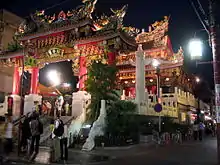
During the Meiji and Taisho eras, it is estimated that up to 100 000 Chinese students came to study in Japan. Japan was both closer to China culturally and in distance than the American and European alternatives. It was also much cheaper.[41] In 1906 alone, more than six thousand Chinese students were in Japan. Most of them resided in the district of Kanda in Tokyo.[42]
Post-World War II
The term shin-kakyō refers to people of Chinese descent who immigrated to Japan from Taiwan and mainland China.
Groups
Foreign students
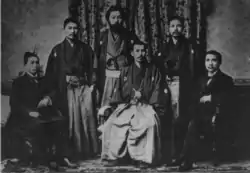
Many famous Chinese intellectuals and political figures have studied in Japan, among them Sun Yat-sen, Zhou Zuoren, Lu Xun, Zhou Enlai and Chiang Kai-shek.
Workers
The industrial 'training scheme' used to bring Chinese workers to Japan has been criticized by lawyers as exploitation, after several deaths.[43]
Others
Many Japanese war orphans left behind in China after World War II have migrated to Japan with the assistance of the Japanese government, bringing along their Chinese spouses and children.
Culture
Cuisine
Chinese restaurants in Japan serve a fairly distinct style of Chinese cuisine. Though in the past Chinese cuisine would have been primarily available in Chinatowns such as those in port cities of Kobe, Nagasaki, or Yokohama, Japanese-style Chinese cuisine is now commonly available all over Japan. As Japanese restaurants often specialise in just one sort of dish, cuisine is focused primarily on dishes found within three distinct types of restaurants: ramen restaurants, dim sum houses, and standard Chinese-style restaurants.
Education
As of 2008 there are five Chinese day schools in Japan:[44] two in Yokohama and one each in Kobe, Osaka, and Tokyo.[45] Three are oriented towards the Republic of China on Taiwan while two are oriented towards mainland China.[44] In Japanese the PRC-oriented schools are called tairiku-kei, and the ROC-oriented schools are taiwan-kei.[46] The ROC-oriented schools teach Traditional Chinese and Bopomofo while the mainland-oriented schools teach Simplified Chinese and Hanyu Pinyin. The ROC-oriented schools, by 2008, also began teaching Simplified Chinese.[44]
As of 1995 most teachers at these schools are ethnic Chinese persons who were born in Japan. By that year there were increasing numbers of Japanese families sending their children to Chinese schools. Other students at Chinese schools are Japanese with mixed Chinese-Japanese parentage, Japanese children with Chinese parents, and returnees from abroad.[47]
Sun Yat-sen established the Yokohama Chinese School in 1898. In 1952 it split into the mainland-aligned Yokohama Yamate Chinese School and the ROC-aligned Yokohama Overseas Chinese School. The Kobe Chinese School is also oriented towards mainland China.[44] The Osaka Chinese School is located in Naniwa-ku, Osaka.[48] There is also the Tokyo Chinese School.
Media
The Chūnichi Shinpo, a biweekly paper, is published in Chinese and Japanese. The Chūbun and Zhongwen Dabao, both weekly newspapers, and about 28 other Chinese newspapers are published in Tokyo. In addition the Kansai Kabun Jihō, published in Chinese and Japanese, is based in the Osaka area.[45]
Issues
Ethnic relations
During his time in office, former Tokyo governor Shintaro Ishihara publicly used controversial terms such as sangokujin to refer to Taiwanese Benshengren staying illegally in Japan, and implied that they might engage in rioting and looting in the aftermath of a disaster.[49]
I referred to the "many sangokujin who entered Japan illegally." I thought some people would not know that word so I paraphrased it and used gaikokujin, or foreigners. But it was a newspaper holiday so the news agencies consciously picked up the sangokujin part, causing the problem.
... After World War II, when Japan lost, the Chinese of Taiwanese origin and people from the Korean Peninsula persecuted, robbed and sometimes beat up Japanese. It's at that time the word was used, so it was not derogatory. Rather we were afraid of them.
... There's no need for an apology. I was surprised that there was a big reaction to my speech. In order not to cause any misunderstanding, I decided I will no longer use that word. It is regrettable that the word was interpreted in the way it was.[50]
Notable individuals
This is a list of Chinese expatriates in Japan and Japanese citizens of Chinese descent.
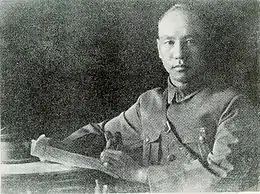
Before 20th century
- Koxinga or Zheng Chenggong, Prince of Yanping, Chinese Ming loyalist, founder of the House of Koxinga and the first ruler of the Kingdom of Tungning (currently Taiwan); born in Hirado, Hizen Province (currently Hirado, Nagasaki), son of a Chinese father (Zheng Zhilong) and a Japanese mother (Tagawa Matsu)
Early 20th century
- Chen Kenmin, chef regarded as the "father of Sichuan cuisine" in Japan and father of Chen Kenichi (born in Yibin, Sichuan Province)
- Go Seigen, professional Go player (Real Name: Wu Qingyuan, Chinese: 吳清源, born in Minhou County, Fujian Province, People's Republic of China)
- Sun Yat-sen, politician (born in Cuiheng, Guangdong)
- Lu Xun, writer (born in Shaoxing, Zhejiang)
- Qiu Jin, feminist (born in Xiamen, Fujian)
- Shosei Go, professional baseball player (born in Taiwan)
- Chiang Kai-shek, politician and general (born in Ningbo, Zhejiang or Xikou, Zhejiang)
- Song Jiaoren, revolutionary and political figure, founder of Tongmenghui (born in Taoyuan, Hunan)
- Jiang Baili, general (born in Haining, Zhejiang)
- Guo Moruo, poet and political figure (born in Leshan, Sichuan)
- He Yingqin, general (born in Xingyi, Guizhou)
- Wang Jingwei, revolutionary and political figure (born in Sanshui, Foshan, Guangdong)
- Dai Jitao, political figure (born in Guanghan, Sichuan)
- Chen Duxiu, co-founder of Chinese Communist Party (born in Anqing, Anhui)
- Li Dazhao, co-founder of Chinese Communist Party (born in Tangshan, Hebei)
- Zhou Zuoren, writer (born in Shaoxing, Zhejiang)
- Huang Fu, general and politician (born in Shangyu, Zhejiang)
- Chen Qimei, revolutionary (born in Huzhou, Zhejiang)
- Zhou Enlai, politician (born in Huai'an, Jiangsu)
Late 20th century
- Momofuku Ando, founder of Nissin Foods, with Japanese Taiwan origins and ROC citizenship. (Born in Puzi, Chiayi County, Taiwan)
- Chen Kenmin, Sichuan-born Sichuan-style chef in Japan (born in Yibin, Sichuan Province)
- Chen Kenichi, son of Chen Kenmin, also a Sichuan-style chef and longest-serving participant on Japanese cooking show Iron Chef (born in Tokyo, Japan)
- Chire Koyama, table tennis player, formerly known as He Zhili (born in Shanghai, China)
- Agnes Chan, pop singer, professor, and writer (born in Hong Kong)
- Lou Zhenggang, artist (born in Heilongjiang)
- Lee Teng-hui, politician (born in Sanzhi District, New Taipei, Taiwan)
- Rissei Ō, professional Go player (born in Taiwan)
- O Meien, professional Go player (Real Name: Wang Ming-wan, simplified Chinese: 王铭琬; traditional Chinese: 王銘琬; pinyin: Wáng Míngwǎn; born in Taipei, Taiwan)
- Sadaharu Oh, professional baseball player (Chinese Name: Wang Chen-chih, Chinese: 王貞治; pinyin: Wáng Zhēnzhì; born in Sumida, Tokyo, Japan)
- Rin Kaiho, professional Go player (Real Name: Lin Haifeng, Chinese: 林海峰; pinyin: Lín Hǎifēng; born in Shanghai, China)
- Cho U, professional Go player (born in Taipei, Taiwan)
- Chin Shunshin, novelist (born in Kobe, Hyogo, Japan)
- Judy Ongg, actress, singer, author, and woodblock-print artist (born in Taipei, Taiwan)
- Teresa Teng, Taiwanese (ROC) pop singer (born in Baozhong, Yunlin, Taiwan)
- Yinling, swimsuit model, race queen, singer and former professional wrestler (Real Name: Yan Yinling, simplified Chinese: 颜垠凌; traditional Chinese: 顔垠凌; pinyin: Yán Yínlíng; born in Taipei, Taiwan)
- Kimiko Yo, award-winning Japanese actress of Republic of China nationality (born in Yokohama, Kanagawa)
21st century
- Mo Bangfu, author (born in China)
- Emi Suzuki, female model (immigrant; born in Shanghai, China)
- Kaito Nakahori, composer (1/2 Chinese, 1/2 Japanese; born in Chiba Prefecture, Japan)
- Wei Son, female model (immigrant; born in Dalian, Liaoning)
- Leena, female model (immigrant; born in Tai'an, Shandong)
- Qian Lin & Li Chun, singers (Qian Lin: born in Hangzhou, Zhejiang/Li Chun: born in Yueyang, Hunan)
- Rola Chen, gravure idol (Real Name: Chen Yi, simplified Chinese: 陈怡; traditional Chinese: 陳怡; pinyin: Chén Yí; born in Hangzhou, Zhejiang)
- Zheng Yongshan, murderer (born in China)
- Jian Kabe, con artist (born in China)
- Renhō, politician (born to a Taiwanese father)
See also
- Japanese missions to Imperial China
- Japanese missions to Sui China
- Japanese missions to Tang China
- Japanese missions to Ming China
- Tokyo Mazu Temple
- Yokohama Ma Zhu Miao
- Kumemura
- Chinatown
- Chinatowns in Asia
- Anti-Japanese sentiment in China
- Anti-Chinese sentiment in Japan
- Japanese orphans in China
- Japanese people in China
Notes
- "SUWA Haruo (諏訪春雄)". 18 January 2018.
References
- "在日华人统计人口达92万创历史新高". www.rbzwdb.com.
- 在日中国人、過去最多の92万人に 中国ネット「口では反日と言っておきながら・・・」(2018年1月18日) - エキサイトニュース
- "国籍・地域別在留外国人数の推移" [Changes in the Number of Foreign Residents by Country/Region] (PDF). Ministry of Justice Japan. 27 March 2020.
- 国籍・地域別 在留資格(在留目的)別 在留外国人 [Status of residence by nationality / region (purpose of stay). Other foreigners]. Japanese Bureau of Statistics (in Japanese). 1 December 2015. Archived from the original on 10 June 2016. Retrieved 6 May 2016.
- "Immigration Control and Refugee Recognition Act, Cabinet Order No. 319 of 1951". Ministry of Justice, Japan. 4 October 1951. Retrieved 22 November 2016.
- Maher 1995, pp. 125–138.
- Refsing 2003, pp. 48−63.
- "Yayoi linked to Yangtze area". Archived from the original on 22 February 2017. Retrieved 14 February 2018.
- Hays, Jeffrey. "YAYOI PERIOD AND THE ORIGIN OF MODERN JAPANESE PEOPLE | Facts and Details". factsanddetails.com. Retrieved 23 November 2020.
- 崎谷満『DNA・考古・言語の学際研究が示す新・日本列島史』(勉誠出版 2009年)(in Japanese)
- Hays, Jeffrey. "RICE AGRICULTURE IN THE YAYOI PERIOD | Facts and Details". factsanddetails.com. Retrieved 23 November 2020.
- 鳥越憲三郎『原弥生人の渡来 』(角川書店,1982)、『倭族から日本人へ』(弘文堂 ,1985)、『古代朝鮮と倭族』(中公新書,1992)、『倭族トラジャ』(若林弘子との共著、大修館書店,1995)、『弥生文化の源流考』(若林弘子との共著、大修館書店,1998)、『古代中国と倭族』(中公新書,2000)、『中国正史倭人・倭国伝全釈』(中央公論新社,2004)
- 諏訪春雄編『倭族と古代日本』(雄山閣出版、1993)また諏訪春雄通信100
- Nonaka, I.; Minaguchi, K.; Takezaki, N. (2007). "Y-chromosomal Binary Haplogroups in the Japanese Population and their Relationship to 16 Y-STR Polymorphisms". Annals of Human Genetics. 71 (4): 480–495. doi:10.1111/j.1469-1809.2006.00343.x. hdl:10130/491. ISSN 1469-1809. PMID 17274803. S2CID 1041367.
- Kutanan, Wibhu; Chakraborty, Ranajit; Eisenberg, Arthur; Sun, Jie; Chantawannakul, Panuwan; Ghirotto, Silvia; Pittayaporn, Pittayawat; Srikummool, Metawee; Srithawong, Suparat (July 2015). "Genetic and linguistic correlation of the Kra–Dai-speaking groups in Thailand". Journal of Human Genetics. 60 (7): 371–380. doi:10.1038/jhg.2015.32. ISSN 1435-232X. PMID 25833471. S2CID 21509343.
- 崎谷満『DNA・考古・言語の学際研究が示す新・日本列島史』(勉誠出版 2009年
- Vovin, Alexander. "Out of Southern China?". Cite journal requires
|journal=(help) - RECONSTRUCTING THE LANGUAGE MAP OF PREHISTORICAL NORTHEAST ASIA - Juha Janhunen Studia Orientalia 108 (2010)
- Lee Sean; Hasegawa Toshikazu (22 December 2011). "Bayesian phylogenetic analysis supports an agricultural origin of Japonic languages". Proceedings of the Royal Society B: Biological Sciences. 278 (1725): 3662–3669. doi:10.1098/rspb.2011.0518. PMC 3203502. PMID 21543358.
- Bellwood, Peter (2013). The Global Prehistory of Human Migration. Malden: Blackwell Publishing. ISBN 9781118970591.
- Vovin, Alexander. "Out of Southern China?". Cite journal requires
|journal=(help) - Archaeological Explanation for the Diffusion Theory of the Japonic and Koreanic Languages - MIYAMOTO Kazuo
- Encounters of the Eastern Barbarians, Wei Chronicles
- Ng, Wai-ming (26 February 2019). Imagining China in Tokugawa Japan: Legends, Classics, and Historical Terms. SUNY Press. ISBN 9781438473086.
- Brownlee, John S. (1 November 2011). Japanese Historians and the National Myths, 1600-1945: The Age of the Gods and Emperor Jinmu. UBC Press. ISBN 9780774842549.
- 諏訪春雄編『倭族と古代日本』(雄山閣出版、1993)また諏訪春雄通信100
- "Yayoi linked to Yangtze area". www.trussel.com. Retrieved 23 April 2019.
- 崎谷満『DNA・考古・言語の学際研究が示す新・日本列島史』(勉誠出版 2009年)
- "Why did Xu Fu go to Japan?". China Radio International. 18 February 2005. Archived from the original on 8 May 2005. Retrieved 25 October 2006.
- A Blessing over the Sea: The Tōshōdai-ji Exhibition, in Shanghai, What are the Highlights of an Exclusive visit to the Tangzhaoti Temple Exhibition? on YouTube, Documentary on Buddhist Monk, Jianzhen, who made a sea voyage to the East (to Japan), to teach the precepts of Buddhism to the Japanese. / Dec 2019, minutes 1:19 (with subtitles).
- Schottenhammer 2012, p. 71.
- "Rinzai-Obaku zen | Head Temples - Engakuji Temple". zen.rinnou.net. Retrieved 26 August 2020.
- Ryon F., Adams. "OUTFOUGHT AND OUTTHOUGHT: REASSESSING THE MONGOL INVASIONS OF JAPAN" (PDF). U.S. Army Command and General Staff College.
- 『元史』巻二百八 列傳第九十五 外夷一 日本國「(至元十八年)官軍六月入海、七月至平壷島(平戸島)、移五龍山(鷹島?)、八月一日、風破舟、五日、文虎等諸將各自擇堅好船乘之、棄士卒十餘萬于山下、衆議推張百戸者爲主帥、號之曰張總管、聽其約束、方伐木作舟欲還、七日日本人來戰、盡死、餘二三萬爲其虜去、九日、至八角島、盡殺蒙古、高麗、漢人、謂新附軍爲唐人、不殺而奴之、閶輩是也、蓋行省官議事不相下、故皆棄軍歸、久之、莫靑與呉萬五者亦逃還、十萬之衆得還者三人耳。」
- Hays, Jeffrey. "WOKOU: JAPANESE PIRATES | Facts and Details". factsanddetails.com. Retrieved 26 August 2020.
- Hays, Jeffrey. "WOKOU: JAPANESE PIRATES | Facts and Details". factsanddetails.com. Retrieved 26 August 2020.
- Hays, Jeffrey. "WOKOU: JAPANESE PIRATES | Facts and Details". factsanddetails.com. Retrieved 26 August 2020.
- Kerr 2000, p. 76.
- Ching, J. (1975). Chu Shun-shui, 1600-82. A Chinese Confucian Scholar in Tokugawa Japan. Monumenta Nipponica 30 (2), 177-191.
- "Zheng Chenggong | Chinese pirate". Encyclopedia Britannica. Retrieved 26 August 2020.
- Jansen 1970.
- Kreiner, Mohwald & Olschleger 2004, pp. 240–242.
- Aoki, Mizuho (23 July 2010). "Stop exploiting trainees as cheap labor". The Japan Times. Retrieved 12 January 2016.
- Co, Emily (23 December 2008). "School bridges China-Japan gap: Historic Yokohama institute seeks to nurture Chinese values, equip pupils for life in Japan". The Japan Times. Retrieved 22 November 2016.
- Gottlieb, Nanette (2008). "Japan: Language Planning and Policy in Transition". In Robert B. Kaplan; Richard B. Baldauf (eds.). Language Planning and Policy in Asia: Japan, Nepal, Taiwan and Chinese characters. Multilingual Matters. p. 133. ISBN 978-1-84769-095-1. Retrieved 12 January 2016.
- Arisawa, Shino (有澤 知乃; Tokyo Gakugei University International Student Exchange Center (留学生センター)). "(A Research Note)Music Education at Overseas Chinese Schools in Japan : The Cases of Yokohama Yamate Chinese School and Yokohama Overseas Chinese School" ((研究ノート)中華学校における音楽教育 : 横浜山手中華学校と横浜中華学院を事例として; Archive). Bulletin of Tokyo Gakugei University Humanities and Social Sciences II (東京学芸大学紀要. 人文社会科学系. II). 66, 205-215, 30 January 2015. Tokyo Gakugei University. See profile at CiNii. See profile at ETopia, Tokyo Gakugei University Repository (東京学芸大学リポジトリ). English abstract available. CITED: p. 215 (English abstract).
- Maher 1995, p. 131: See Table 2. also: "A surprising trend in recent years is for some Japanese parents to send their children to Chinese schools" and "The overwhelming majority of teachers in Chinese schools are Japan-born Chinese residents (e.g. Yokohama Yamate 25 teachers: 19 Japan-born Chinese, 4 Japan- born Japanese, 2 mainland China-born)."
- Fujikata, Satoru (30 August 2011). "Japanese parents see value of Chinese, Indian schools". Asahi Shimbun. Archived from the original on 8 March 2015. Retrieved 12 January 2016.
- Larimer, Tim (24 April 2000). "Rabble Rouser". Time Asia. 155 (16). Archived from the original on 8 April 2013. Retrieved 12 January 2016.
- "'There's No Need For an Apology': Tokyo's boisterous governor is back in the headlines". Time Asia. Vol. 155 no. 16. 24 April 2000. Archived from the original on 8 April 2013. Retrieved 12 January 2016.
Sources
- Jansen, Marius B. (1970). The Japanese and Sun Yat-sen. Stanford University Press. ISBN 978-0-8047-0700-8.
- Kerr, George H. (2000). Okinawa: The History of an Island People. Tuttle Publishing. ISBN 978-0-8048-2087-5.
- Kreiner, Josef; Mohwald, Ulrich; Olschleger, Hans-Dieter (2004). Modern Japanese Society. Brill Academic Publishers. pp. 240–242. ISBN 978-90-04-10516-4.
- Maher, John C. (1995). "The kakyo: Chinese in Japan". Journal of Multilingual and Multicultural Development. 16 (1–2): 125–138. doi:10.1080/01434632.1995.9994596.
- Refsing, Kirsten (2003). "In Japan, but not of Japan". In Mackerras, Colin (ed.). Ethnicity in Asia. Routledge. ISBN 978-1-134-51517-2.
- Schottenhammer, Angela (2012). "The "China Seas" in world history: A general outline of the role of Chinese and East Asian maritime space from its origins to c. 1800". Journal of Marine and Island Cultures. 1 (2): 63–86. doi:10.1016/j.imic.2012.11.002.
- Soderberg, Marie; Reader, Ian (2000). Japanese Influences and Presences in Asia. United Kingdom: Routledge. ISBN 978-0-7007-1110-9.
Further reading
- Chen, Lara Tien-shi. "Chinese in Japan." Encyclopedia of Diasporas. Springer US, 2005, Part III, pp 680–688. DOI: 10.1007/978-0-387-29904-4 70. Print ISBN 978-0-306-48321-9, Online ISBN 978-0-387-29904-4.
- Le Bail, Hélène. "SKILLED AND UNSKILLED CHINESE MIGRANTS IN JAPAN" (Archive). Les cahiers d’Ebisu. Occasional Papers No. 3, 2013, pp. 3–40. French Research Institute on Japan, Maison Franco-Japonaise (日仏会館).
- Shao, Chunfen. "Chinese Migration to Japan, 1978-2010: Patterns and Policies" (Part IV: Chinese Migration in Other Countries: Chapter 11). "A Biographical Study of Chinese Immigrants in Belgium: Strategies for Localisation." In: Zhang, Jijiao and Howard Duncan. Migration in China and Asia: Experience and Policy (Volume 10 of International Perspectives on Migration). Springer Science & Business Media, 8 April 2014. ISBN 940178759X, 9789401787598. Start p. 175.
External links
- Naturalized Japanese
- Tokyo Chinese School
- Yokohama Overseas Chinese School
- Beech, Hannah. "Chinese Immigrants Chase the Japanese Dream." TIME Magazine. 6 December 2007.
